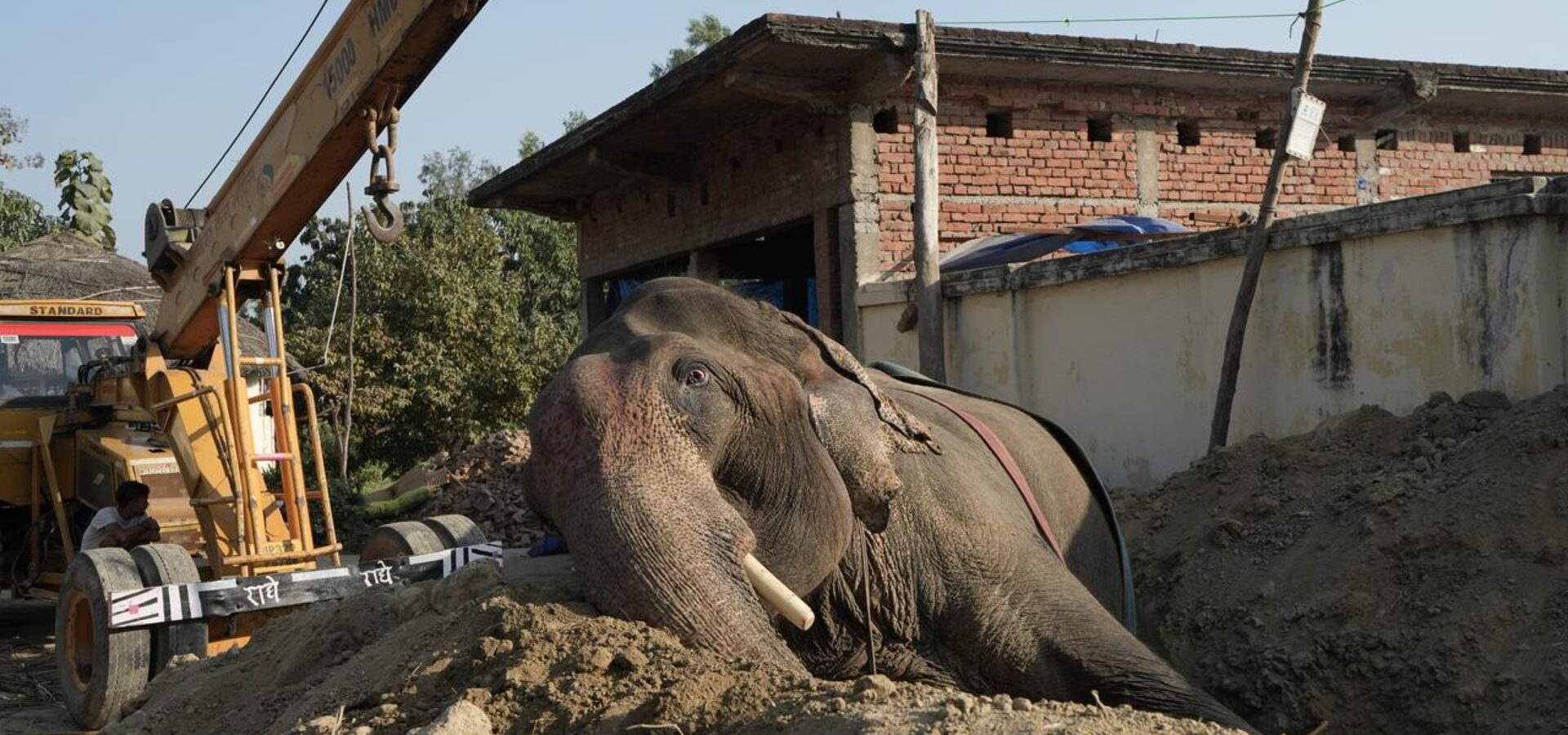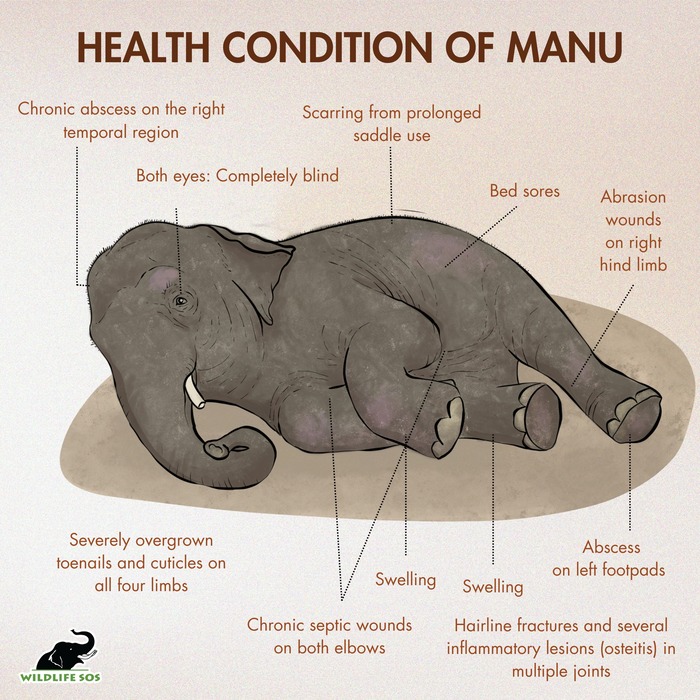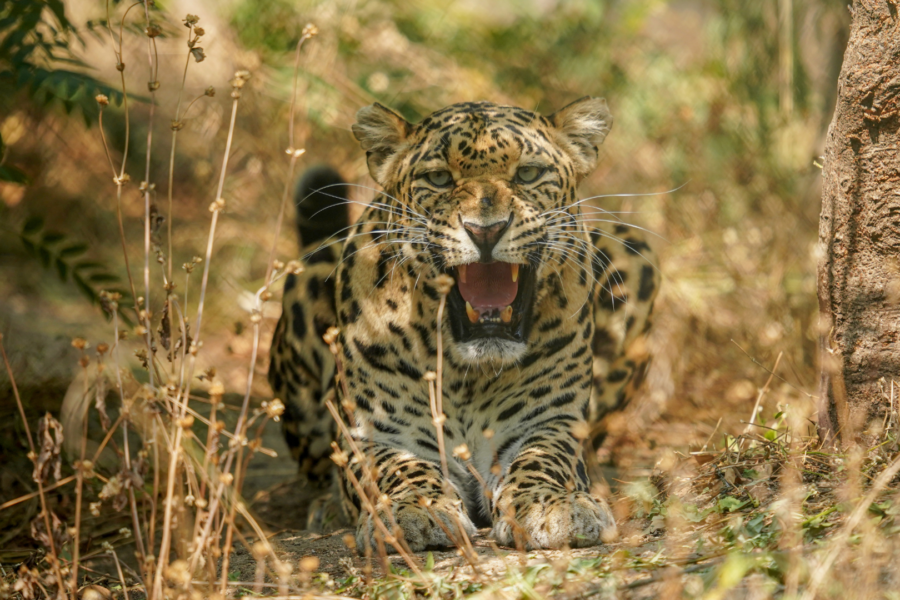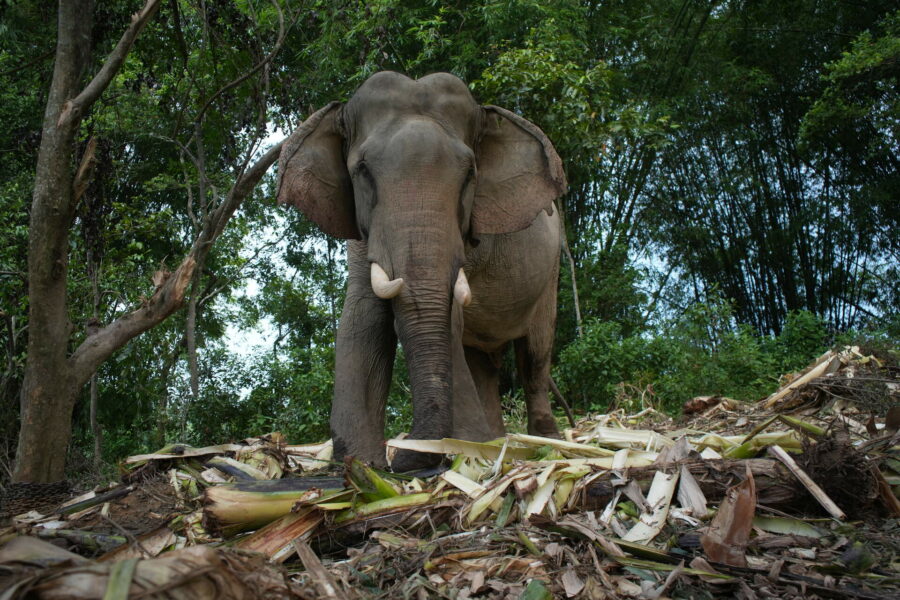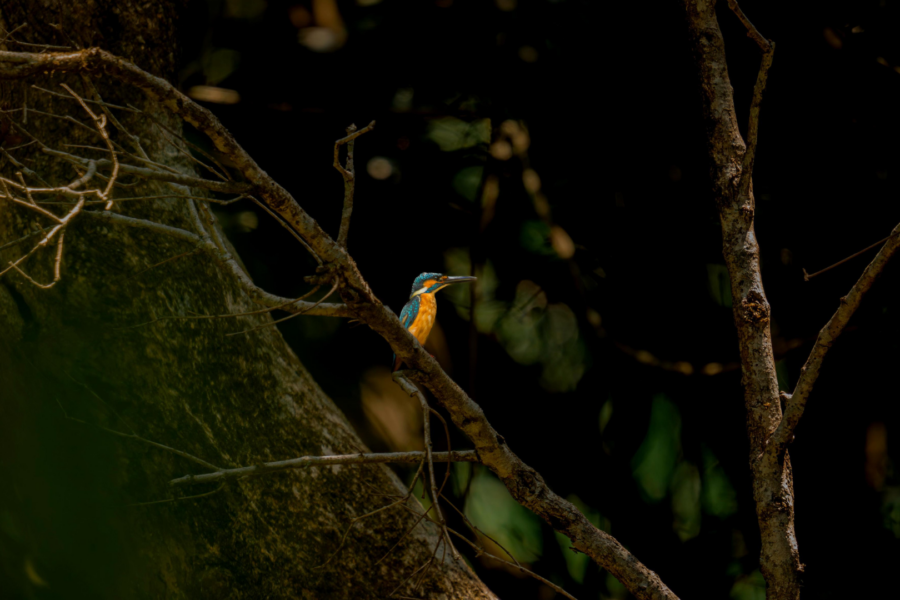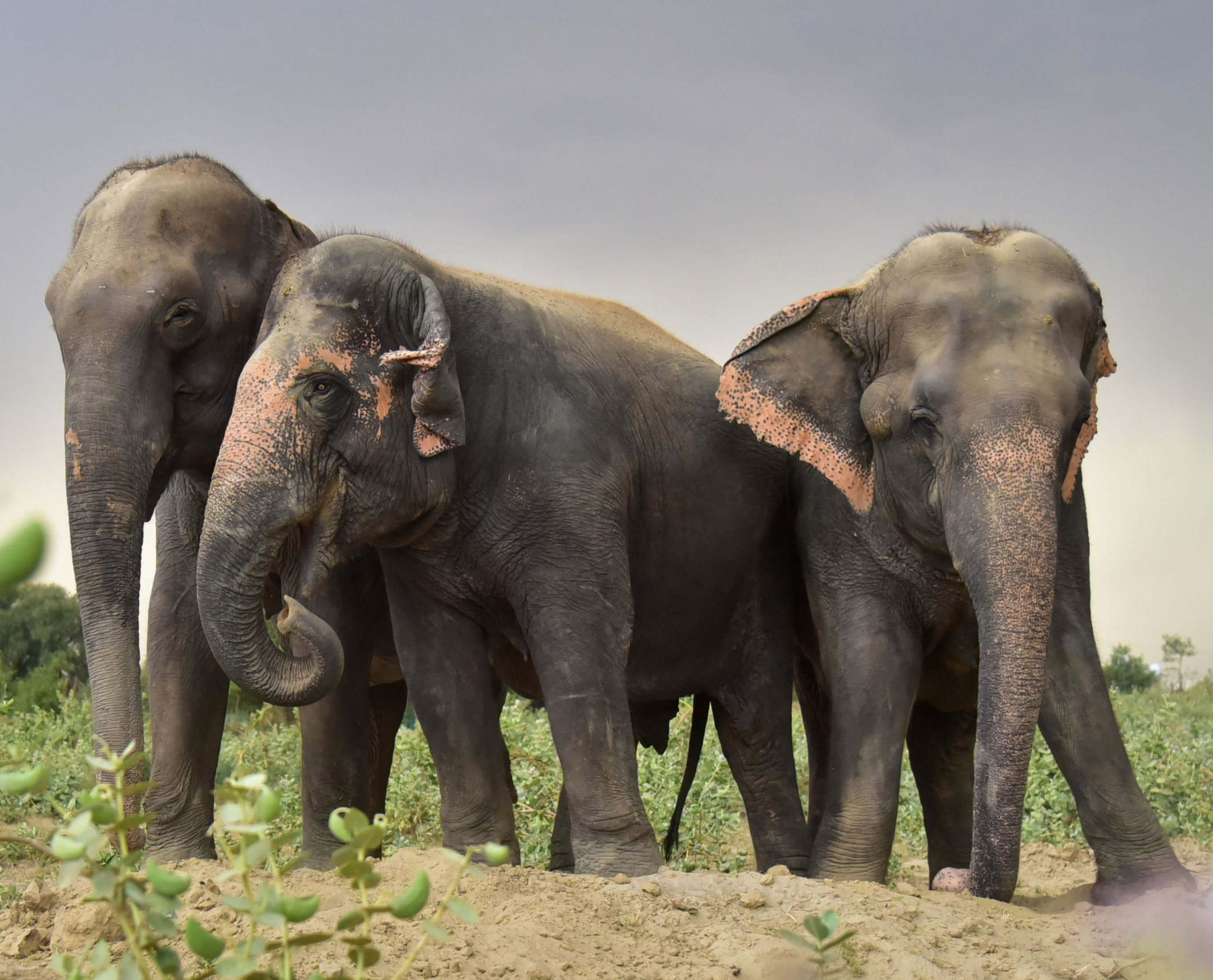February 2025 began with a distressing call to Wildlife SOS that would set the stage for an intense and heart-wrenching operation. Manu, a 58-year-old elephant, was found collapsed in a remote part of Uttar Pradesh, unable to rise, and in severe distress. His frail body had endured the toll of neglect and untreated injuries, leaving him in a critical condition. Realizing the graveness of the situation, his owners turned to Wildlife SOS for help.
As our team rushed to his side, Manu lay there motionless, weakened by dehydration. Painful swellings in his limbs, and chronic septic wounds present on his elbow regions were visible. We knew time was running out; we had to act fast with our resources and expertise to give Manu a fighting chance.
2 February 2025
01.00 AM
After a 700-km long journey, the rescue team, including Dr. Rahul (veterinarian), and support staff, has reached the site where the pachyderm had collapsed. He had been lying in the same position for more than 36 hours. His right forelimb appeared compromised, and he was severely dehydrated.
Initial examination revealed inflammation on the wrist joint and elbow region of his front leg, and near the thigh of his right hindlimb. Prolonged recumbency had caused painful bedsores, and his breathing had slowed down. Witnessing the state of the pachyderm, our team sprang into action. The priority was to stabilize Manu’s condition.

- Years of neglect, combined with untreated injuries and chronic ailments, had left Manu in poor physical condition. [Photo © Wildlife SOS/Atharva Anil Pacharne]
The first step was to administer fluids to address the shock caused by dehydration, and closely monitor his vital signs. Given Manu’s inability to stand, a specialised crane and sling system was required to lift him up.

- A crane was brought in to safely lift Manu, who had been lying in this position for over 36 hours. [Photo © Wildlife SOS/Atharva Anil Pacharne]
To give him strength throughout this process, fruits are being fed to him to keep his energy levels stable. The crane brought in was carefully positioned with great precision to assist Manu to stand upright. It is essential to prevent any further injury, as his limbs were already under significant stress from prolonged immobility.

The lifting process required a careful and coordinated effort from the team to ensure Manu was given ample support. [Photo © Wildlife SOS/Atharva Anil Pacharne]
The crane has helped to lift Manu successfully, and detailed assessment of his injuries is being conducted. Apart from painful bedsores, his joints were stiffened and inflamed from lack of movement. Blood tests and X-rays will further determine his health condition.

- Laser therapy was immediately initiated to reduce the inflammation on Manu’s joints, and his wounds were cleaned to prevent further infection. [Photo © Wildlife SOS/Atharva Anil Pacharne]
As the hours are passing, Manu is beginning to show small but encouraging signs of improvement. His body has started responding to the fluids and pain management procedures, and his appetite is slowly increasing. He is consuming some fruits and vegetables, marking a significant step forward in his healing.
Manu Experiences Love and Care
Manu’s condition remains precarious, but every little sign of progress offers a glimmer of hope. Under the team’s attention and care, his body began to respond positively. Fluid therapy, laser treatment, and massages are being given to reduce swelling, while his wounds are being sanitised and treated meticulously.
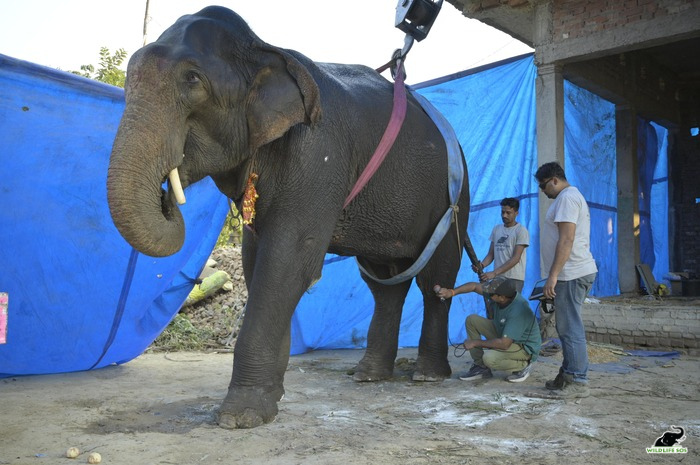
- Manu is responding to the treatment as he stands on all four legs with support of slings. [Photo © Wildlife SOS/Atharva Anil Pacharne]
Improvement in his appetite was reflected in his consumption of 50 kg of fodder, 8 kg of fruits and vegetables, and 45 litres of water over a day. His bowel movement is healthy. X-ray results revealed degenerative joint disease and hairline fractures.

- The x-rays revealed inflammation lesion (osteitis) on edges of the bone due to long term malnourishment. [Photo © Wildlife SOS]
4 February 2025
07.00 AM
Manu managed to stand on his own! As our team watched this, slings were kept ready to ensure his safety. This moment marked a significant milestone in Manu’s fight against all odds, as his body is slowly starting to regain strength.

The Wildlife SOS team breathed a huge sigh of relief to see Manu stand on his own, a reassuring nod to how treatments provided are helping him heal. [Photo © Wildlife SOS/Atharva Anil Pacharne]
Mud beds have also been created around him to provide cushioning and comfort in case he decides to lie down. Movement and changing positions of lying down also reduces the risk of bedsores. Manu’s improved appetite and hydration levels further fueled the team’s cautious optimism as we continue our efforts to aid his recovery.

- Manu is given a warm and soothing bath by our earnest caregivers at the site. [Photo © Wildlife SOS/Atharva Anil Pacharne]
In addition to this mighty breakthrough, Manu received a refreshing bath as well. The bath not only helped improve his blood circulation, but also provided him some much-needed comfort. While the warm water and gentle cleaning was soothing for Manu, our team took this up as an opportunity to inspect his wounds more closely to prevent any risk of infection.

- Bathing is also essential to maintain Manu’s oral hygiene and to prevent any infections. [Photo © Wildlife SOS/Mradul Pathak]
5 February 2025
09.00 AM
With the necessary permissions now in place, preparation of Manu’s transportation to Wildlife SOS Elephant Hospital Campus is being carried out for the next phase of his treatment. A sanitised ambulance has been arranged to transport him on the 700-km journey to the elephant hospital.
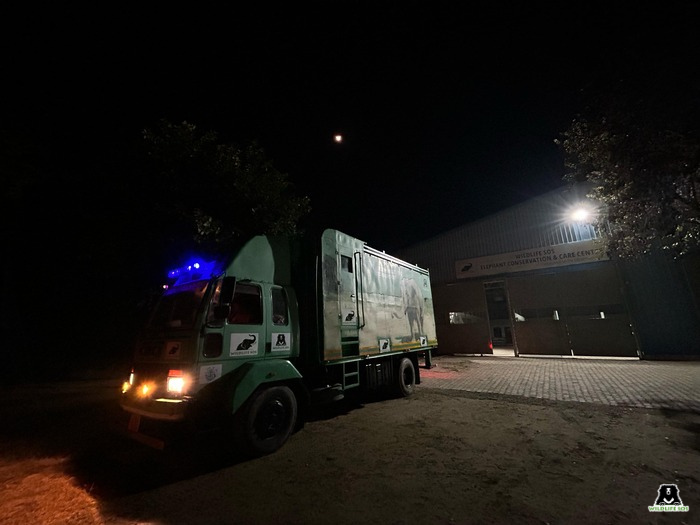
- The ambulance at Elephant Hospital Campus has been equipped with several blankets to ensure that Manu stays warm during the journey. [Photo © Wildlife SOS/Mradul Pathak]
Understanding his fragile condition, the team has taken extra precautions by installing a pulley system inside the ambulance. This would provide additional support in case Manu needed assistance to stand with the help of slings.
Plenty of fresh fruits, vegetables, and fodder are being packed to keep him nourished during the trip. Since we’ve learned that Manu enjoys eating sugarcane and apples, our team has made sure to carry along plenty of these stalks to keep him at ease along the way.
After following all the necessary requirements, the ambulance finally set off into the night to save Manu.
6 February 2025
03.00 PM

- Wildlife SOS animal ambulance en route to Manu’s location. [Photo © Wildlife SOS/Mradul Pathak]
It was noon when our ambulance arrived at the site, fully sanitised and prepared for the journey. However, after assessing Manu’s condition, the team decided that he needed more time before attempting transportation.

- Ensuring Manu’s stability before the long journey became crucial to prevent any stress or complications for the ailing elephant. [Photo © Wildlife SOS/Mradul Pathak]
One of the biggest challenges Manu is facing is his reluctance to lie down and rest. Having only ever rested on hard, flat surfaces, he was hesitant to lower himself onto the mud beds we had created for him, fearing that he might not be able to stand again. However, for Manu to get better, he had to get some rest—and convincing the weary pachyderm to do so required us to do some thinking on our part.

- Our team working hard to ensure that Manu gets some much needed rest. [Photo © Wildlife SOS/Atharva Anil Pacharne]
After a discussion on how to help him feel more at ease, our team redesigned the mud beds—flattening the tops and creating a gentle depression in the middle to mimic lower ground. This modification was aimed at encouraging him to confidently shift his weight and eventually take rest, which was essential for his healing.

- Our veterinary team continues to conduct detailed examinations of Manu’s swollen limbs and chronic wounds to track his progress. [Photo © Wildlife SOS/Atharva Anil Pacharne]
Meanwhile, his treatments continue. Laser therapy eases inflammation in his joints, while hot fomentation and pain management are helping to improve his mobility. His wounds were carefully cleaned and dressed, and his diet is closely monitored for his nourishment and hydration.

- Manu receives vital antibiotics, vitamins, and fluids to aid his recovery. [Photo © Wildlife SOS/Mradul Pathak]
While preparations to move him remain underway, the team is taking every measure to ensure that when Manu is finally ready to travel.
7 February 2025
8.00 PM
With Manu showing gradual improvement owing to laser therapy, hydration and essential medication, the team is making sure that his vehicle for transport is also equipped with necessary requirements for the pachyderm’s journey towards Wildlife SOS’s Elephant Hospital.
Ambulance Preparation
Manu’s safety during the transport required meticulous planning. The team dug a trench in the mud where the vehicle was parked so that the platform to enter the ambulance could be lowered for Manu to step inside it easily.

- A JCB excavator was used to create the trench where the vehicle stood, and a sling system was carefully set up inside the ambulance to provide Manu support in case he needed assistance to stand. [Photo © Wildlife SOS/Mradul Pathak]
11.30 PM
The most delicate part of the operation was finally about to unfold—getting Manu safely into the ambulance. Understandably, he displayed signs of hesitation and anxiety, reluctant to step into the unfamiliar space. The process was painstakingly slow, but by midnight, Manu had finally stepped into the ambulance, ready for the journey!

- Our team exercised immense patience, using gentle guidance and encouragement to coax Manu into entering the ambulance. [Photo © Wildlife SOS/Mradul Pathak]
8 February 2025
12.00 AM
After assessing Manu’s stability within the ambulance, the Wildlife SOS team began its journey through the night. The drive had to be steady, smooth and controlled, and the speed was kept moderate to prevent any undue stress on Manu’s fragile body.
01.35 AM
After covering a significant distance, the team made their first pit stop to check on Manu. He appeared stable, showing no signs of distress. His vitals were also monitored closely.
05:00 AM
A second pit stop was taken, allowing the team to pause and power up with hot tea for the long journey ahead. Meanwhile, Manu continued to remain composed, reassuring our team of his comfort. He expressed his desire for food through a rumbling call, which is a very positive indication of his increasing appetite and strength.

- As the journey progressed, Manu remained under constant observation, with every possible precaution taken to ensure his well-being. [Photo © Wildlife SOS/Atharva Anil Pacharne]
08.00 PM
Manu has finally arrived at the Wildlife SOS Elephant Hospital Centre! After a 20-hour journey, he is now entering a safe environment where he can begin his journey of healing. The trauma of his past will always linger, but with each day of love and specialised care, we hope to make it a distant memory.
As the ambulance neared the final stop, an unexpected sight brought smiles to their tired faces—a playful trunk peeped out from the top of the ambulance! Elephants rely heavily on their sense of smell, and perhaps Manu could already sense love and freedom in the air.
![While all of us at Wildlife SOS waited to welcome Manu, the pachyderm instinctively lifted his trunk from the top of the ambulance, as though he was reaching out to his new world of freedom! [Photo © Wildlife SOS]](https://wildlifesos.org/wp-content/uploads/2025/02/Untitled-design-11-2.png)
- While all of us at Wildlife SOS waited to welcome Manu, the pachyderm instinctively lifted his trunk from the top of the ambulance, as though he was reaching out to his new world of freedom! [Photo © Wildlife SOS/Mradul Pathak]
As soon as the ambulance doors opened, Manu hesitated at first. His initial apprehension, however, was short-lived. A sudden chorus of welcoming trumpets from the other elephants at the centre echoed around us. These calls seemed to reassure dear Manu, and with a newfound confidence, he took his first steps towards his new beginning.

- Manu walks out of the ambulance as other resident elephants welcome him with a chorus of trumpets. [Photo © Wildlife SOS/Vineet Kumar Singh]
9 February 2025
Manu’s first day at the centre was set to be special—a day of celebration for his new beginning. A soothing bath was given to him first to wash away the exhaustion of his long journey.

As water cascaded over his body, Manu seemed to relax, taking in this new caring experience. [Photo © Wildlife SOS/Mradul Pathak ]
Bathing is not only a vital part of an elephant’s daily care, but also a moment of comfort, and for Manu, it was the first true taste of the kindness he would come to know here.
Health Update: Manu’s Road to Recovery
Manu’s suffering has been unimaginable—decades of relentless abuse, neglect, and pain. Every scar on his frail body tells a heartbreaking story: wounds from heavy saddles, fractures that never healed, and, most tragically, blindness. A thorough examination confirmed our worst fears—Manu has completely lost his vision and will never see the world again.

- [Infographic (c) Wildlife SOS/ Parul Sneha]
At the Wildlife SOS Elephant Hospital in Mathura, Manu is now receiving urgent medical care. Our veterinary team is working tirelessly to ease his pain, treating his wounds with dressings, joints with laser therapy and massages, and other essential supplements such as multivitamins for his strength and well-being.
Bridge to Recovery
Manu’s first steps at the hospital took place on the weighing bridge present at the facility. At Wildlife SOS, weighing every elephant is a crucial protocol to assess their overall health, determine if they are underweight or overweight, and tailor their nutrition and medical care accordingly. For elephants like Manu, who have suffered injuries and mobility challenges, maintaining an ideal weight is critical.
As Manu stood patiently on the scale, this moment marked the beginning of a new chapter of his life under care.
4.00 PM | Manu’s First Fruit Feast
Manu’s first day at the centre had to be special! As part of our welcoming ritual, a juicy fruit feast was laid out for Manu to indulge in. This also gave us a glimpse into his preferences—he took his time with every bite, favouring bananas and apples while clearly rejecting papayas.

- As Manu settles into his new surroundings, we are learning about his likes and dislikes, just as he is learning to trust us. [Photo © Wildlife SOS/Mradul Pathak]
His journey towards healing has only just begun, and with nutritious food and critical medical care, we will do everything we can to help him regain his strength.
After the mayhem of the past few days, we are finally able to utter the words we’ve longed to say: Welcome home, Manu.
Manu needs your help. By making a donation, you can help us support Manu’s medical care and treatments that he urgently requires.

